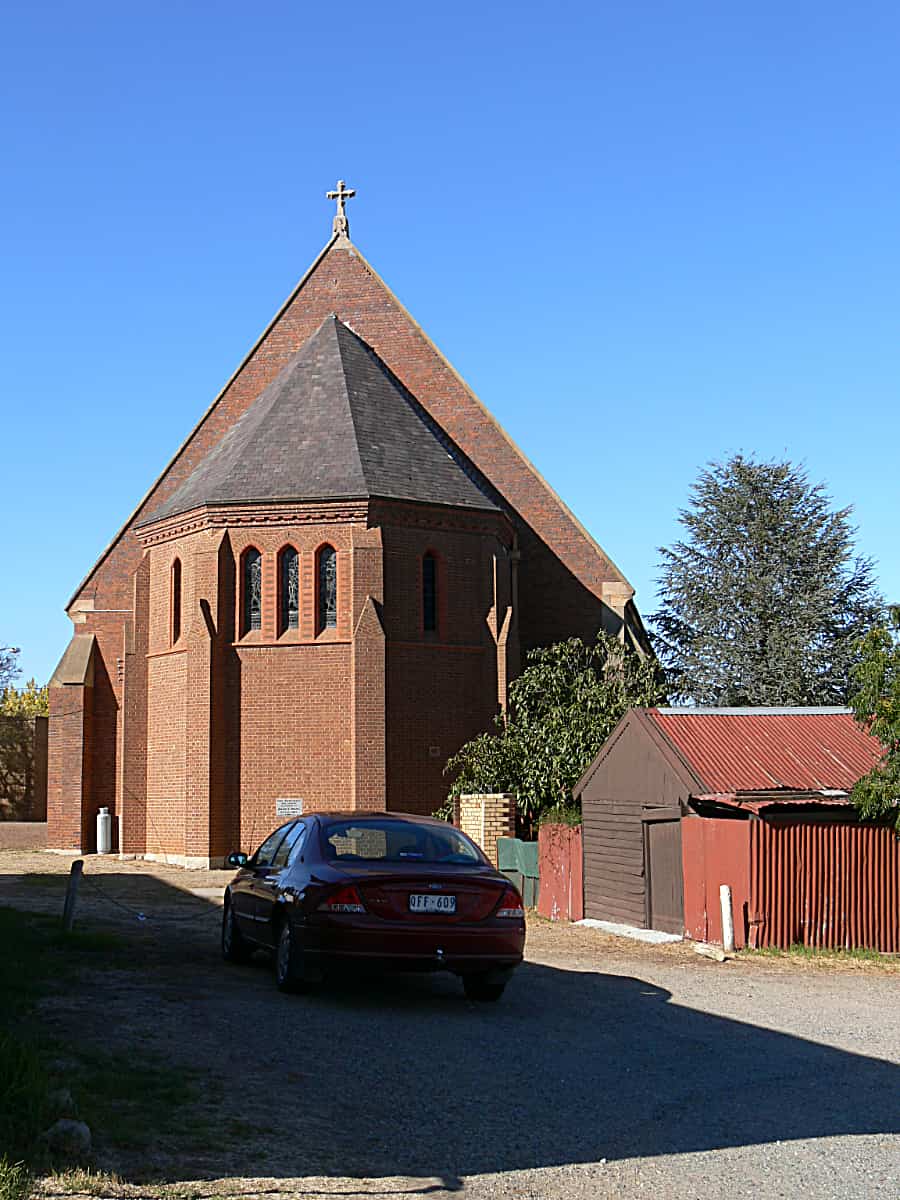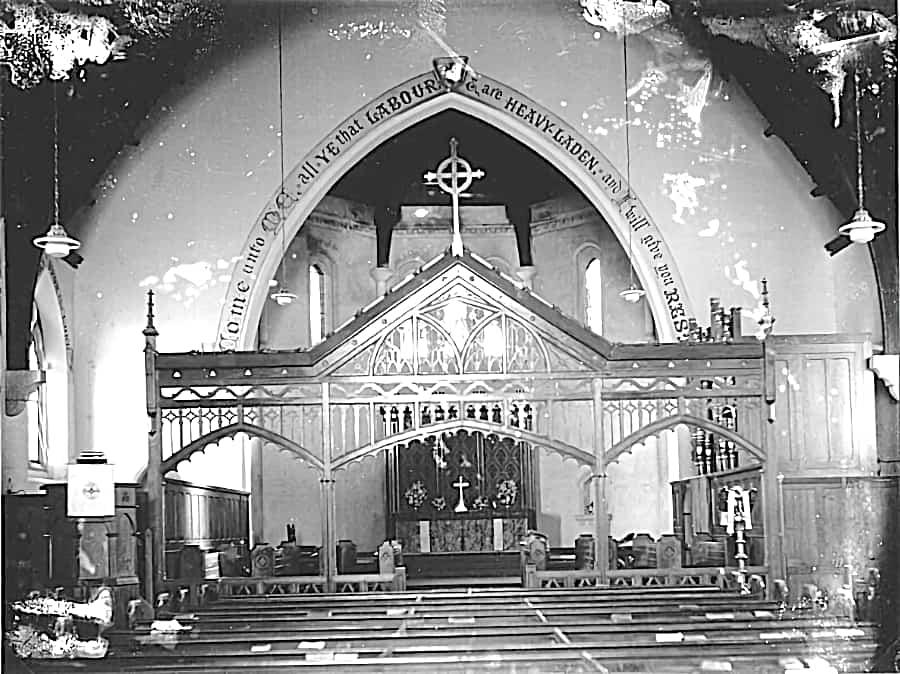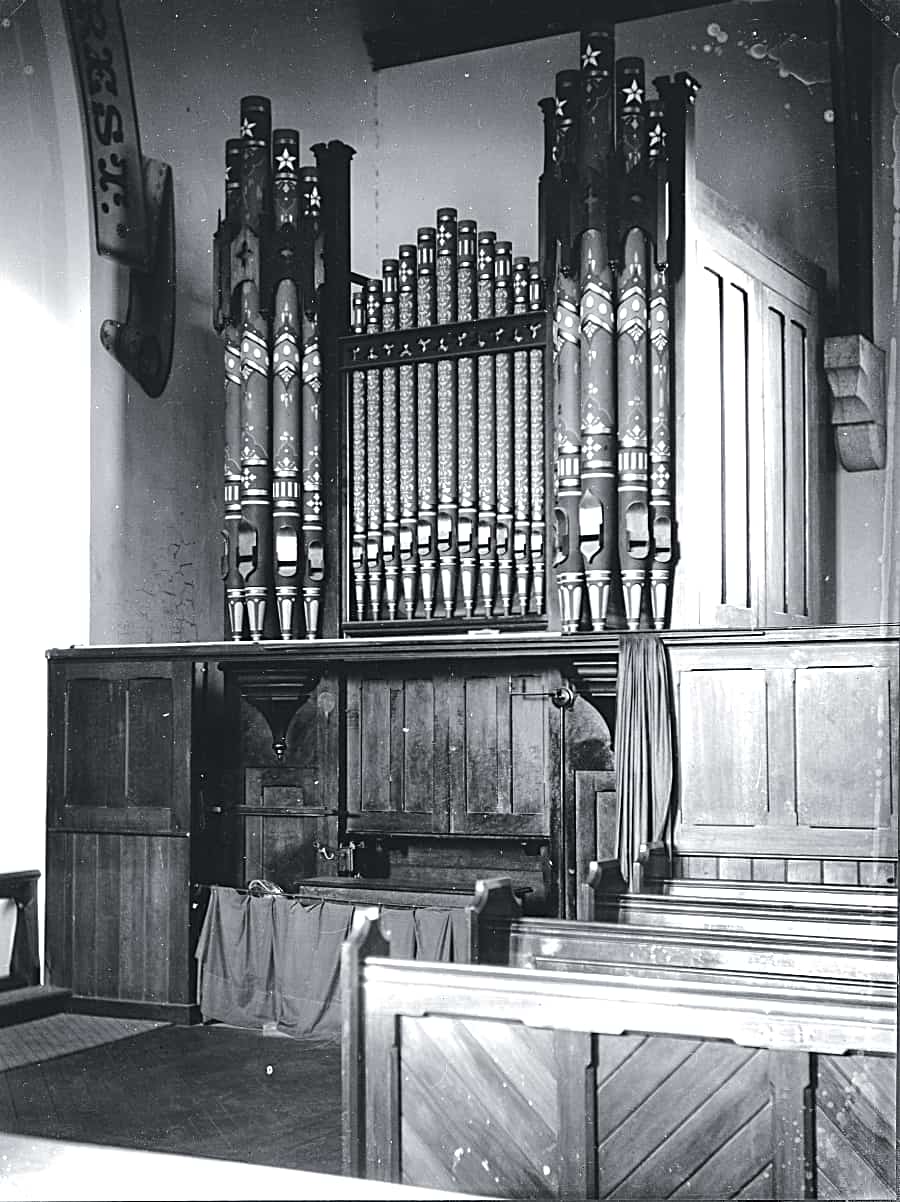
Holy Trinity Anglican Church, Stawell – exterior
[photograph by John Maidment (20 April 2009)]
Historical and Technical Documentation by John Maidment
© OHTA, November 2021 (last updated November 2021)

Holy Trinity Anglican Church, Stawell – exterior
[photograph by John Maidment (20 April 2009)]
Historical and Technical Documentation by John Maidment
© OHTA, November 2021 (last updated November 2021)
Holy Trinity Church was designed by architect Leonard Terry. The foundation stone was laid on 13 April 18701 and the building opened in 1872. An apsidal sanctuary, reredos, altar and rails were later added to the building in 1926-27, designed by Louis R. Williams.2 The building contains stained glass by Ferguson & Urie and William Montgomery.3

Holy Trinity Anglican Church, Stawell – sanctuary exterior
[photograph by John Maidment (20 April 2009)]

Holy Trinity Anglican Church, Stawell – interior after 1927 with organ to the right, sanctuary and chancel screen
[photograph from Victorian Collections]
A two-manual organ of 11 speaking stops built by Fincham & Hobday was opened on 21 November 1894 by Dr G.W. Torrance, who was also the consultant. The cost was £337.10s.4
The local newspaper Pleasant Creek News reported at length on the acquisition of the organ:
The new organ at the Holy Trinity Church, Stawell, will be opened on Wednesday, 7th November. The organ is built by Messrs. Fincham and Hobday, the well-known organ builders. The organ will be erected on the site occupied by the present instrument, which will necessitate the removal of the pulpit to the opposite side of the chancel, the new organ being of much larger dimensions than the one in use at present. It will measure 16 feet in height, and 8 feet 6 inches across the front, and will be a two-manual instrument, fitted with patent pneumatic motion [action] sound boards, and will be of complete power for the size of the church. It is claimed for the new organ that it will be the best instrument yet made in the colony at the price, viz. £340, including the cost of erection. Of this sum £200 will have to be paid down, towards which £175 has been already subscribed. At the opening service, Dr. Torrance, Mus. Doc. Of Dublin, and incumbent of Holy Trinity Church, Balaclava, will preside at the organ and preach the sermon at the dedicatory service. On the following evening, an organ recital, to be advertised in due course, will be given by Dr. Torrance, when lovers of music may with perfect confidence expect an unusual treat from the master hand of that celebrated composer and musician. The choir of Holy Trinity are making special preparations for the opening ceremony.5
THE FIRST PIPE ORGAN FOR STAWELLAn event of more than denominational interest will be the opening on Thursday next of the first pipe organ introduced into this town. The gentlemen who about 20 years ago erected the Church of the Holy Trinity must have had great faith in the future of Stawell, or in the religious instincts of the people. It is doubtful whether there is any ecclesiastical edifice in the colony, outside of Melbourne, Ballarat and Geelong, that has a nave 100 feet long by 45 feet broad, and a roof whose apex is 50 feet from the ground. Divine service in such a building naturally requires a powerful rendering if it is to be adequately felt, and especially is this the case in regard to the music. The worshippers of Holy Trinity have been fortunate enough to possess a large Mason and Hamblin [Hamlin] American organ of exceedingly fine tone, but from the nature of the case it could not adequately fill their spacious building. The matter of obtaining a pipe organ has therefore been in the mind of the congregation for several years, but owing to other claims upon members of the church it was only at the beginning of August last year that the managing body saw their way to give an order to Messrs. Fincham and Hobday, who are the leading organ builders of the colony.
The new instrument is constructed on the latest improved tubular pneumatic principle. It contains great organ 5 stops, swell organ 5 stops, pedal organ 1 stop and 6 couplers, and has composition action. The whole of the specifications are arranged to suit the special requirements of the church.
The organist at the various special services which are to mark the opening will be the Rev. Dr. George William Torrance, Mus. Doc., incumbent of Holy Trinity, Balaclava, and incumbent-elect of St John’s , Melbourne – one of the most distinguished musicians in Victoria. Dr. Torrance was educated at Trinity College, Dublin, where he graduated B.A. in 1864, M.A. in 1867, Bachelor and Doctor of Music in 1879. He was ordained deacon and priest by the Bishop of Lichfield 1865-1866. He is the author and composer of “Music in its relation to religion,” “Music of the Australian Aboriginals”.6

Holy Trinity Anglican Church, Stawell – the organ
[photograph supplied by the Stawell Historical Society]
The organ was later moved to the right side of the chancel where it is shown above.
| GREAT Open Diapason Claribel Dulciana Principal Fifteenth Swell to Great Sub Swell to Great Swell to Great Super |
8 8 8 4 2 |
||
| SWELL Open Diapason Gedact Gamba Flute Oboe Tremulant |
8 8 8 4 8 |
||
| PEDAL Bourdon Great to Pedal Swell to Pedal |
16 |
Tubular-pneumatic action7
The organ is almost identical in specification with the instrument at the Uniting Church, Carngham. The simple two-tower case is similar in appearance to those in other Fincham instruments such as the Uniting Church, Richmond, Vic, Union Memorial Presbyterian Church, North Melbourne (destroyed), Holy Trinity Anglican Church, Port Melbourne (now at St Joseph’s Catholic church, Edgecliff, NSW) and elsewhere.
The organ was removed c.1965 by Hungarian émigré S.I. Sakacs and some parts were used in a new organ for the Baptist Church, St Ives, NSW,8 now at the Baptist Church, East Lindfield, NSW after further rebuilding by Anthony Welby.
1 Church of England Messenger, 19 May 1870, p.8; Ballarat Star, 15 April 1870, p.3
2 Gladys Marie Moore, Louis Reginald Williams (Master of Planning and Design thesis, University of Melbourne, 2001), appendix, p.4, The Argus, 18 June 1927, p.33
3 https://monumentaustralia.org.au/themes/conflict/ww1/display/104157-holy-trinity-war-memorial, accessed 18 November 2021; https://fergusonandurie.wordpress.com/2012/11/16/02-12-1871-holy-trinity-anglican-church-stawell-victoria/, accessed 18 November 2021 and personal communication Dr Bronwyn Hughes OAM, 22 November 2021
4 E.N. Matthews, Colonial Organs and Organbuilders. Carlton: Melbourne University Press, 1969, p.176. Note that Matthews erroneously describes the builder as George Fincham.
5 Pleasant Creek News, 16 October 1894, courtesy of the Stawell Historical Society
6 Ibid., 20 November 1894, courtesy of the Stawell Historical Society
7 George Fincham letter book vol 15, 4 August 1894, p.82
8 The Bulletin, 13 September 1969